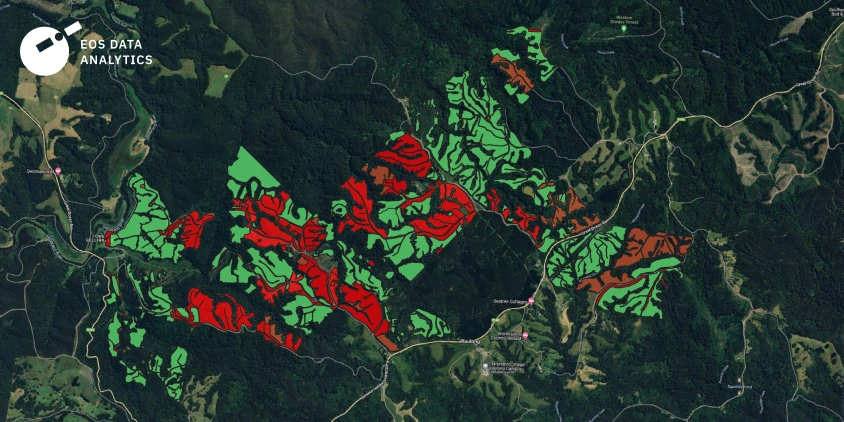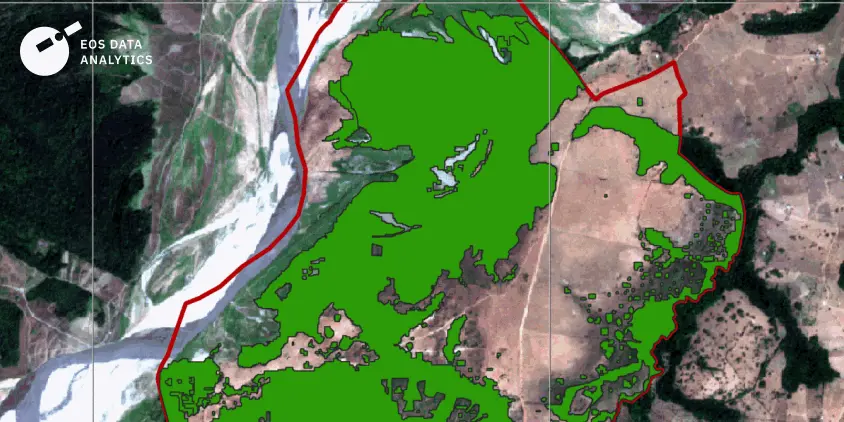
How EUDR Compliance Drives Demand For Satellite Data
The European Union Deforestation Regulation has become a significant concern for businesses across industries, particularly those dealing with agricultural and forestry products. As companies prepare to meet the new compliance requirements, the pressure to ensure deforestation-free supply chains is mounting. Insights from EOSDA’s Yevhenii Marchenko, Sales Team Lead, and Oleksii Neskorovnyi, Business Analyst, shed light on how businesses are adapting to these regulations and the impact on market dynamics.
In October 2023, we already covered the essentials of EUDR and what it meant for businesses. Since then, however, key changes have occurred, including a delayed implementation timeline and shifts in market demands. As a global provider of satellite data analytics, we’ve observed an increasing number of businesses seeking advanced monitoring solutions to meet the EUDR’s strict requirements. This post will explore these changes and provide updated insights into how companies are navigating this evolving regulatory landscape.
Recap Of EUDR And Key Changes Since 2023
The European Union Deforestation Regulation (EUDR) is aimed at ensuring that products entering the EU market are not contributing to deforestation. The regulation requires businesses to conduct due diligence and provide proof that their supply chains are free from deforestation-related activities.
When we initially covered this topic in October 2023, businesses were in the early stages of preparing for compliance, focusing on the traceability of products such as coffee, cocoa, and wood. Since then, several key changes have taken place. Most notably, the European Council agreed to delay the implementation of EUDR by one year, giving businesses more time to adapt . This decision was largely influenced by major industry players who expressed concerns about their readiness to meet the stringent requirements .
In the meantime, the demand for satellite-based monitoring solutions has been rising. More and more companies look for reliable, scalable ways to meet the EUDR’s transparency and traceability requirements. We’ve also observed a clear shift in how businesses are investing in compliance, with many looking for advanced technologies and solutions that can streamline the due diligence process.
The Demand For Satellite Monitoring Grows
As a global provider of AI-powered satellite data analytics, we see a significant increase in requests for monitoring solutions, particularly from industries most affected by the EUDR, such as agriculture, forestry, and commodities like coffee and cocoa. Businesses are recognizing the value of satellite data in tracking land use changes and ensuring that their supply chains are deforestation-free, as required by EUDR.
Our solutions, such as deforestation detection, forest health monitoring and crop classification, have become essential for companies aiming to meet the EUDR’s strict requirements. By offering up-to-date insights and historical data analysis, we help companies verify land use changes and avoid penalties for non-compliance.

This surge in demand is fueled by the complexity of the supply chains and the need for precise, reliable data to meet regulatory standards. According to Yevhenii Marchenko, our Sales Team Lead, the need for satellite monitoring solutions has also grown as companies move from physical inspections to remote, data-driven verification processes.
One major challenge we observe is ensuring that all stakeholders across the supply chain, from producers to operators, have access to accurate data. By integrating satellite forest monitoring into their existing systems, businesses want to streamline their compliance efforts and reduce their reliance on manual verification processes. This shift towards data-driven compliance is both more efficient and more scalable, especially for larger companies operating in high-risk regions.
Challenges And Opportunities For Businesses Adapting To EUDR
The complexity of complying with EUDR lies not only in ensuring deforestation-free supply chains but also in managing the vast amount of geolocation data required for due diligence. Businesses face the challenge of tracing every link in their supply chain, often across multiple regions, while providing proof that their products are sourced sustainably. For many, this involves gathering data from suppliers, implementing traceability systems, and continuously monitoring land use to ensure no violations occur.
Satellite monitoring has emerged as a solution to address at least some of these challenges. By providing accurate, large-scale data, it helps companies reduce their reliance on physical inspections and allows them to focus on risk areas more effectively. Additionally, by using AI-powered tools to detect changes in forest cover or assess the health of agricultural areas, businesses streamline their compliance processes and lower the costs associated with manual verification.
At the same time, these challenges present opportunities for innovation. Companies that invest early in compliance technology are better positioned to navigate future regulatory changes, potentially gaining a competitive edge. As the EUDR continues to evolve, so too will the demand for advanced monitoring solutions that offer both precision and scalability.
The Role Of Automation In EUDR Compliance
One of the most significant trends we’ve observed in the market is the increasing demand for automated solutions to streamline EUDR compliance. Automation can simplify the process of monitoring deforestation and tracking supply chains, reducing the burden on businesses that are already facing high compliance costs. Several companies are exploring semi-automated systems that allow users to input geolocation data, which is then analyzed to provide reports on deforestation or land use changes without requiring human intervention.
At EOSDA, we recognize the value of automation but also understand its limitations. While automation can expedite the compliance process, there are cases where more detailed, custom analysis is necessary, especially in complex supply chains or high-risk regions. As noted by Oleksii Neskorovnyi, Business Analyst at EOSDA, relying solely on automation might not always capture the full picture, particularly when it comes to subtle changes in forest health or illegal activities that could be overlooked by automated systems.

The future of EUDR compliance likely lies in a hybrid approach: using automation to handle the bulk of data processing and analysis, while still involving human oversight for complex cases. This balanced approach allows businesses to leverage the speed and efficiency of automation while ensuring the accuracy and reliability of their compliance efforts.
The Future Of Market Dynamics And Regulatory Expansion
Looking ahead, the satellite monitoring market is expected to grow significantly as more businesses turn to data-driven solutions to comply with the EUDR. Over the next 2-3 years, we at EOSDA expect to see an increased adoption of advanced technologies such as AI-based change detection and multispectral imaging for detailed land use analysis. These tools will become essential as companies seek more precise ways to monitor deforestation and ensure compliance across complex supply chains.
As regulations evolve, there is also a possibility that the EUDR could expand to cover additional commodities and regions. While the current focus is on high-risk products like coffee, cocoa, and wood, there is growing discussion about including other commodities, such as grains and textiles. This expansion would further drive demand for satellite monitoring solutions, as companies in these industries would need to meet the same stringent due diligence requirements.
Moreover, with competition in the market increasing, businesses will likely continue to seek out monitoring solutions that offer not only compliance but also operational efficiency. Companies that can integrate satellite data with their internal systems, providing a seamless experience, will be at a clear advantage.
As we move forward, the focus will be on delivering solutions that balance precision, scalability, and cost-effectiveness.
Conclusion: Adapting To A New Regulatory Landscape
The EUDR represents a major shift in how businesses must approach sustainability and supply chain transparency. As the regulation evolves and expands, companies that proactively invest in compliance technologies, such as satellite monitoring, will be better positioned to navigate this complex regulatory environment. At EOSDA, we’ve observed a growing demand for our advanced solutions, which are helping businesses meet these new challenges head-on.
While the path to full compliance can be daunting, the tools and technologies available today — combined with human expertise where needed — offer a way forward. By integrating satellite data, automating key compliance processes, and staying ahead of future regulatory expansions, businesses can not only meet EUDR requirements but also gain a competitive edge in the market.
As the regulatory landscape continues to change, we remain committed to providing our clients with the insights and solutions they need to succeed.
About the author:
Maksym Sushchuk is at the forefront of realizing EOSDA's vision to make space tech a global driver of sustainability on Earth. He has over 15 years of experience in journalism and content creation for prominent Ukrainian startups, charitable funds and ESG businesses. As Head and Co-founder of PR Army Maxim brings attention to the human and social tolls of the aggression against Ukraine.
Recent articles

Analyze 2025 & Plan Your Best Year Yet: LandViewer Christmas Offer
It’s the most wonderful time of the year! The Christmas holidays are here, and so is your chance to analyze 2025 and plan a prosperous 2026 with more affordable Pro plans in LandViewer.

EOSDA Models Climate Change Impact On Sugarcane Yields
EOSDA modeled future temperature, rainfall, and other climate impacts on Veracruz sugarcane. The results help growers plan long-term adaptation strategies, including timing, varieties, and irrigation.

EOSDA LandViewer Black Friday Sale: Exclusive Offers & Giveaway
This Black Friday, LandViewer offers new users the chance to save on monthly plans, get extra months with yearly subscriptions, and participate in a free annual plan giveaway.

